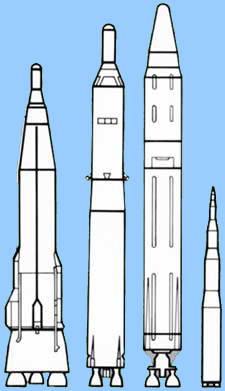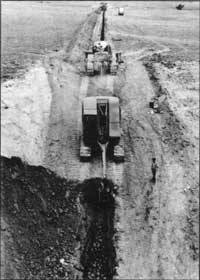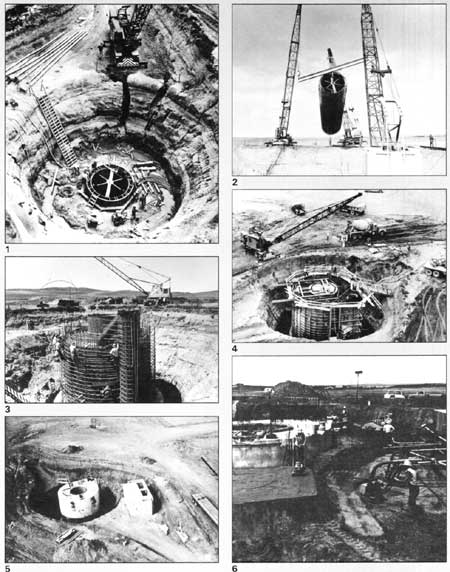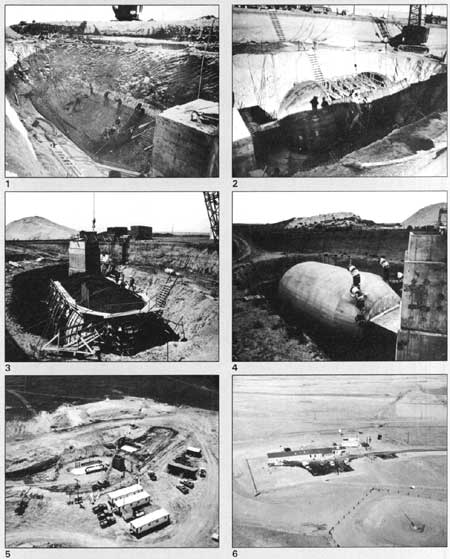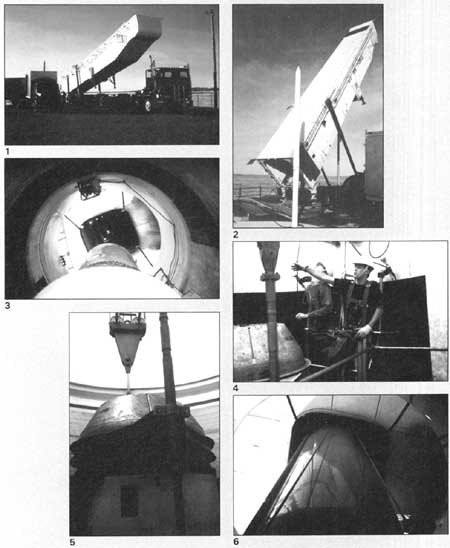|
MINUTEMAN MISSILE National Historic Site |
U.S. Department of the Interior National Park Service |

|

|
|
A Delta Flight missile being removed from its silo. ROBERT LYON |
History of Minuteman Missile Sites
The Minuteman ICBM Missile System
On October 4, 1957, the Soviet Union successfully launched into orbit the world's first artificial satellite, Sputnik. Ham radio operators in the eastern United States turned their dials to lower frequency bands and anxiously listened as the 184-pound Sputnik emitted a mechanical ". . . beep . . . beep . . . beep . . ." while passing overhead. Other radio operators quickly recorded the broadcast and, within hours, Americans in their living rooms heard Sputnik's transmission via radio and television news flashes. The message seemed to confirm America's worst fears: the Soviets had technologically surpassed the United States and gained supremacy of outer space. The Soviet scientific community wasted little time boasting about their apparent win. Immediately after the launch, one Muscovite scientist commented, "Americans design better automobile tailfins, but we design the best intercontinental ballistic missiles and earth satellites. " In the United States, one headline proclaimed: "U.S. Must Catch Up with Reds or We're Dead. "
In truth, the significance of the successful launching was not so much Sputnik, but the huge Soviet rocket that hurled the satellite into space. With Sputnik, which is Russian for "fellow traveler," the Soviets demonstrated the ability of their SS-6 launcher to propel a missile toward a target thousands of miles away. Four years earlier, the Soviets exploded the "Hbomb. " Now, the frightening prospect of a Soviet missile delivering a nuclear bomb to an American city in less than an hour revived what some called a "Pearl Harbor atmosphere" throughout the United States. At the urging of his military advisors and under tremendous public pressure, President Dwight D. Eisenhower reluctantly accelerated America's ICBM program.
The shock of Sputnik abruptly reversed what Air Force Secretary Donald Quarles had characterized as America's "poor man's approach" to the ICBM program. Within six months after Sputnik, the Nation's space research and development budget mushroomed from an average half billion dollars a year to more than $10.5 billion. Much of the money went to the development of the Minuteman missile. In 1958, Congress increased the appropriation for Minuteman from $50 to $140 million. The following year, Congress added two billion dollars to the Minuteman budget, to be spread out over the next five years.

|
|
Vice President Richard M. Nixon, President Dwight D. Eisenhower, and Secretary of State John Foster Dulles (left to right) at the Brown Palace Hotel, Denver, Colorado, August 1952. WESTERN HISTORY DEPARTMENT, DENVER PUBLIC LIBRARY. |
Sputnik sparked the development and deployment of the Minuteman missile. But the origins of the Minuteman missile program were deeply rooted in the years immediately following World War II — when the world's two superpowers began to engage in the spiralling arms race of the Cold War.
Origins of the Arms Race
On January 7, 1954, President Eisenhower delivered his first State of the Union address to the Nation. After declaring that "American freedom is threatened so long as the Communist conspiracy exists in its present scope, power and hostility" the President outlined his plans for defending the Nation against that threat. "We will not be aggressors," he said, "but we . . . have and will maintain a massive capability to strike back." Eisenhower's comments reflected the doctrinal basis behind much of America's strategic planning during the Cold War era.
President Eisenhower's view of the Soviet Union was similar to one that had been articulated nearly eight years earlier by George Kennan, a diplomat at the US embassy in Moscow. Watching the Soviets surround themselves with a "buffer zone" that included much of eastern Europe following World War II, Kennan had argued that these moves resulted from a fanatical Soviet "expansionism" that was ultimately bent on disrupting American society, destroying the American way of life, and breaking the international authority of America. The only way to deal with this threat, Kennan suggested, was for the United States to adopt a policy of "patient but firm and vigilant containment of Russian expansive tendencies."
Although good in theory, containment proved nearly impossible to put into practice. In order to truly contain the pervasive Soviet threat, observed one top US official in 1954, the Nation would need to prepare for combat "in the Arctic and in the tropics; in Asia, in the near East and in Europe; by sea, by land, and by air. " But while the Soviet Union had mounted a massive effort to rebuild its army and replenish conventional weapons after World War II, America had demobilized at a dizzying rate. Exploiting its position as the sole possessor of the atomic bomb, the United States pursued what some observers called a "bargain-basement" defense policy, using nuclear weapons as stand-ins for foot soldiers.
Fiscally conservative, President Eisenhower also wanted to keep America's atomic arsenal to the minimum amount necessary to deter Moscow. The President and his chief economic advisor, Arthur H. Burns, believed that the Federal government needed to cut spending, reduce taxes, and balance the budget in order to achieve steady economic growth. Despite protests from the Joint Chiefs of Staff, Eisenhower continually pressed for large cuts in military spending, which consumed almost 70% of the national budget at the time he took office in 1953.
The American ICBM Program
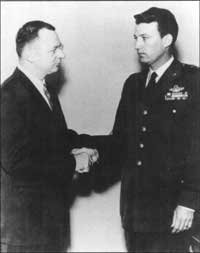
|
|
Air Force Assistant Secretary for Research and Development Trevor Gardner (left) and Maj. General Bernard A. Schriever (right) were key players in the development of intercontinental ballistic missiles, including the Minuteman. US AIR FORCE, HISTORY DIVISION. |
American military planners began developing ballistic missiles immediately after World War II. But by the late 1940s, America's missile program began to languish, largely because the Nation's nuclear superiority seemed secure. In 1949, when the Soviet Union developed its atomic bomb, America responded with an even more powerful weapon — a thermonuclear device that used a small atomic trigger to initiate a fusion reaction in hydrogen isotopes. Successfully tested in 1952, the H-bomb seemed to guarantee America's nuclear superiority. But in August 1953, the Soviets exploded their own H-bomb, and many US military experts also believed that the Soviets could deliver their new weapon via an ICBM. For the first time, the Soviets seemed poised to take the lead in the arms race.
Following the Soviet's successful H-bomb test, two independent US organizations reevaluated the strategic importance of ICBMs to national security. As Dr. Bruno Augenstein of the RAND Corporation observed, "If the Soviet Union beat the United States in a race for the ICBM, the consequences would be catastrophic." An Air Force committee headed by Dr. John von Neumann, a Princeton University mathematics professor, also assessed the arms race. Code-named the "Teapot Committee," von Neumann's group investigated "the impact of the thermonuclear [bomb] on the development of strategic missiles and the possibility that the Soviet Union might be somewhat ahead of the United States. " In February 1954, RAND and the Teapot Committee released their reports, both of which reached the same conclusion: recent advances in thermonuclear technology made an ICBM practical. Furthermore, an ICBM "could be developed and deployed early enough to counter the pending Soviet threat if exceptional talents, adequate funds and new management techniques suited to the urgency of the situation were authorized."
By May 1954, the Air Force had mapped out a development plan for the new weapon. In June, Vice Chief of Staff General Thomas D. White ordered the Air Research and Development Command "to proceed with the development of an ICBM at the highest speed possible, limited only by the advancement of technology in the various fields concerned. " In July, the Air Force established a special project office to administer the program. Based on the West Coast, the new agency was consequently called the Western Development Division. Bernard A. Schriever, a 43-year-old brigadier general, headed Western Development Division. The Air Force expected the newly-promoted young general to place a fully operational ICBM weapon system into the hands of the Strategic Air Command within six years. The Air Force considered Western Development Division's mission so important to national security that even its initials, WDD, were classified beyond top secret.
On August 5, 1954, General Schriever and a small group of military officers converged on an abandoned parochial school in the Los Angeles suburb of Inglewood to begin their work. To avoid arousing the curiosity of nearby residents, the officers wore civilian clothes. Journalist Roy Neal, who chronicled the development of the Minuteman missile system, described what they found:
No sign identified the white schoolhouse as the Western Development Division.
. . . The windows were frosted and heavily barred. All outside doors, except one, were locked. The only entrance was across a chain-link fenced parking lot. A security guard manned the door... Some of the old-timers recall . . . the comment of the school boy who was sauntering by the school building.
Eying the frosted glass and steel-barred windows, he said to a chum, "Boy am I glad I don't go to school here. "
In this inconspicuous but carefully secured setting, the hand-picked staff of the Western Development Division began the effort to build an intercontinental ballistic missile.
| Cold War Timeline | |||
|
First Generation ICBMs: Atlas and Titan
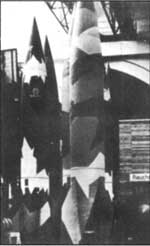
|
|
German V-2 missiles, which Adolph Hitler hailed as Vergeltungswaffe (vengeance weapons), were used against the Allies during the closing years of World War II. DEUTSCHE MUSEUM, MUNICH, GERMANY. |
The Western Development Division staff began its work by reviving a missile project that had originated shortly after World War II. In 1946, the Air Force had contracted with the Convair Corporation to design a long-range ballistic missile called the MX-774. Like many post-war missile projects, the MX-774 lost most of its government funding after only one year. But, instead of dropping the project, Convair Corporation continued working on its own, steadily advancing the state of missile technology. In 1951, the Air Force acknowledged these efforts by hiring the company to develop plans for a more advanced missile, called the Atlas.
The Atlas was essentially a highly evolved version of the German V-2 missile, which Germany had used against the Allies during the waning years of World War II. Like the V-2, the Atlas was powered by rocket engines that burned a mixture of liquid fuel and oxidizer. But while the V-2 had an effective range of only a few hundred miles, the Atlas had to deliver its payload to a target more than 5,000 miles away. Convair Corporation could have met this requirement by designing the Atlas as an enormous version of the V-2. Instead, Convair's engineers sought a more sophisticated solution. Realizing that a missile's range could be increased by reducing its weight, Convair equipped the Atlas with an innovative, ultra-light airframe. Convair assembled the missile from rings of paper-thin stainless steel, stacked together like stovepipes and welded at the seams to form cylinders. The cylinders were then inflated with nitrogen gas to give the missile its structural integrity.
By 1954, the Atlas was the Nation's most advanced ballistic missile. Nonetheless, the missile was years away from production. No prototype had been flight tested, and some skeptics feared that when Atlas's powerful engines were fired for the first time, the missile's thin-skinned airframe would buckle in on itself, leaving America's hopes for an ICBM lying on the launch pad like a gigantic ball of tin foil.
General Schriever and his staff were aware of these concerns. So while they proceeded with the Atlas program, they also looked for a backup. In October 1955, the Air Force contracted with the Glenn L. Martin Company to produce a new ICBM called the Titan. Like the Atlas, the Titan used liquid propellants, but its advanced two-stage design allowed for a conventional, and more reliable, airframe.
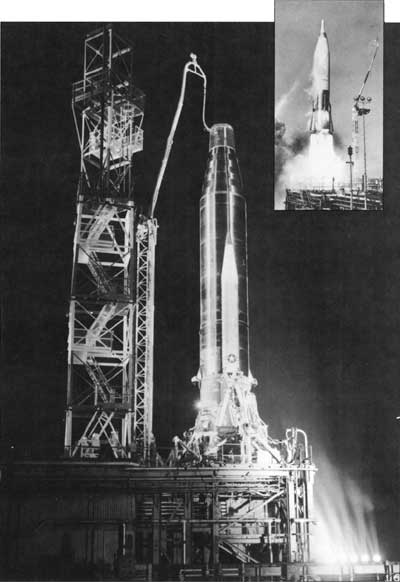
|
|
Atlas missile awaiting test launch from Cape Canaveral on Christmas Eve, 1958. Inset: Test launch of the Atlas D missile. The development of the solid-fueled Minuteman missile accelerated the early retirement of the first generation of liquid-fueled ICBMs, such as the Atlas D and Atlas E, which the Air Force deactivated by 1965. US AIR FORCE, inset photo CONVAIR (ASTRONAUTICS DIVISION), GENERAL DYNAMICS CORPORATION. |
Still, America's missile program was hampered by funding problems. In 1956, Air Force Secretary Donald Quarles rejected the operational budget for the ICBM program, and proposed the elimination of either Atlas or Titan, which he considered redundant. That same year, the Air Force lost its most effective missile proponent when Assistant Secretary Trevor Gardner, the "Missile Czar," announced his retirement, citing continued cuts to his missile research and development budgets. Undeterred by Gardner's retirement, Quarles's austerity campaign continued into 1957 when the ballistic missile program was slashed by $200 million. In July, the Eisenhower administration initiated even more cost-saving measures, including cutting missile deliveries, lowering overtime rates, and delaying payments to contractors.
Strength in Numbers: The Missile Gap
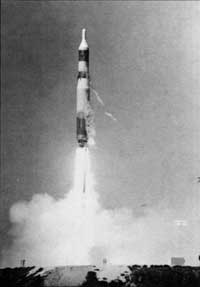
|
|
Titan I test launch, Vandenberg Air Force Base, May 4, 1962. The Titan missile possessed a greater range and bigger payload than Atlas. Still, the Titan was equally short lived. All Titan missiles were deactivated by June 1965. US AIR FORCE |
This frugal economic climate changed dramatically after Sputnik. In October 1957, when the Soviet Union announced it had used a liquid-fueled ICBM to launch Sputnik into orbit, American scientists and politicians feared a significant "missile gap." Within months, journalists and intelligence analysts began asserting that the Soviet missile force could outnumber the American arsenal by as much as 16 to one by 1960. America's growing sense of insecurity was not lost on Soviet officials, who gleefully announced that their factories were turning out missiles "like sausages." Facing severe criticism for allowing the United States to fall behind in the arms race, the Eisenhower administration poured more money into its missile programs — increasing the Nation's annual space research and development budget by more than twenty-fold within six months after Sputnik. The administration also highlighted the development of the Atlas and Titan missiles. One government spokesperson noted that America's missile program was being carefully designed, first to "attain perfection," and then to "develop the ability to produce in volume once that perfection is achieved. "
But America's first-generation ICBMs were neither perfect nor mass-producible. A few weeks after Sputnik, the Wall Street Journal observed that the weaknesses of America's ICBMs "are so profound that . . . generals are sure [the missiles] will be discarded altogether after the first half-dozen years." Atlas and Titan were extraordinarily complex, handcrafted machines, containing as many as 300,000 parts, each of which had to be maintained in perfect operating condition. The liquid propellants that powered the missiles' engines were volatile and corrosive, and could not be placed in the fuel tanks until immediately before launch. In addition, the missile crews needed as much as two hours to fuel the missiles. Consequently, instead of being "stable weapons in a state of permanent readiness," these ICBMs required "the desperate and constant attention accorded a man receiving artificial respiration." The missiles were not a "push button affair but will require a highly-trained crew . . . several times as large as the largest bombing crew. " Many of these problems could be solved, the Wall Street Journal suggested, by developing a simplified "second generation" of missiles powered by solid-fuel rocket engines.
"A lot of work had been done on solids prior to the initiation of the ICBM program in 1954," recalled General Schriever in a 1973 interview, "but there were a number of things that ruled against using solids at that time." Solid propellants in the mid-1950s could not provide enough power to hurl a thermonuclear warhead across an ocean. Also, solids were difficult to manufacture. They were hard to ignite, and there was no way to control their combustion or direct their thrust after ignition. Given these constraints, the Air Force believed that liquid-fueled missiles were "the only immediate way to go ahead. " But the Air Force did not entirely abandon the concept of a solid-fuel missile. In 1956, Schriever reluctantly approved a low-level research program "aimed toward the evolution of a high-thrust . . . solid-fuel rocket." Schriever selected Colonel Edward Hall, Chief of Propulsion Development for the Western Development Division, to head the program. According to historian Robert Perry, Hall was a "near-fanatic" about the potential of solid-fuel missiles.
Weapon System "Q"
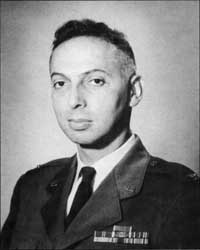
|
|
Colonel Edward Hall spearheaded the US Air Force effort to develop a solid fueled ICBM. COURTESY EDWARD HALL. |
Colonel Edward Hall and his staff of engineers diligently researched their solid-fuel missile program. Within two years, Hall's group had solved most of the problems associated with solid-fuel rocket engines. In August 1957, the Air Force asked Hall to develop a medium-range, solid-fuel missile to be the land-based counterpart to the Navy's submarine-launched, solid-fuel Polaris. Within two weeks, Hall drew up specifications for a remarkable new missile whose range could be varied by simply assembling its three interchangeable propulsion stages in different combinations.
The new missile, dubbed "Weapon System Q," was "the first strategic weapon capable of true mass production," wrote Duke University historian George Reed. "To Hall, the new missile was the perfect weapon for a defense policy characterized by minimum expenditure and massive retaliation; and he urged that this be its chief selling point." Sputnik made it easy for Colonel Hall to make the sale. A few days after the Sputnik launch, Hall went to the Pentagon with General Schriever to build support for the new missile. As they ascended the ranks of the military hierarchy, Hall refined his plans. By the end of 1957, he determined that "the ICBM version of Weapon System Q would be a three-stage, solid-fuel missile approximately 65 feet long, weighing approximately 65,000 pounds, and developing approximately 100,000-120,000 pounds of thrust at launch. " The missile would be stored vertically in underground silos and "would accelerate so quickly that it could fly through its exhaust flames and not be significantly damaged."
In February 1958, Hall and Schriever presented Weapon System Q to the Secretaries of the Air Force and Defense. "We got approval . . within 48 hours," Schriever recalled. The officers immediately renamed the project. On February 28, 1958, the New York Times reported that the Air Force had been authorized "to produce an advanced type of ballistic missile . . . called Minute Man."
Minuteman I
| US ICBM Size Comparisons Atlas, Titan I, Titan II, Minuteman |
|
|
By the end of March 1958, at least seven of the Nation's foremost aircraft manufacturers, including the Boeing Airplane Company, were competing to build the new missile. Although Seattle-based Boeing had built many of the Nation's largest strategic bombers, the company had virtually no experience with missiles. Still, Boeing mounted an all-out effort to win the Minuteman contract, assigning more than 100 employees to work on the project. When the Air Force selection board met to examine the proposals, one top official recalled that "there was no question . . . that Boeing was the right company for the job." In October 1958, the US government contracted with Boeing to assemble and test the new missile.
During the next few months, the rest of the Minuteman missile team came into place. The Thiokol Chemical Company of Brigham City, Utah, the Aerojet General Corporation of Sacramento, California, and the Hercules Powder Company of Magna, Utah, all won contracts to work on the missile's propulsion stages. Minuteman's guidance and control systems went to the Autonetics Division of North American Aviation in Downey, California. The AVCO Corporation of Boston contracted to build the missile's thermonuclear warhead.
Much of the development work for Minuteman took place in northern Utah. Thiokol and Hercules already operated plants in the area and, within a few months, Boeing moved into a new assembly plant that occupied 790 acres at Hill Air Force Base near Ogden. By the beginning of 1960, Boeing's Minuteman work force had grown to nearly 12,000, as the company started to assemble the missiles. Time magazine reported that the desert north of Salt Lake was "boiling" with activity:
Strange lights glare in the night, making the mountains shine, and a grumbling roar rolls across the desert. By day enormous clouds of steam-white smoke billow up . . . and drift over hills and valleys. Monstrous vehicles with curious burdens lumber along the roads.
All these strange goings-on mark the development of the Minuteman, the solid fuel missile that its proponents confidently expect will ultimately replace the liquid fuel Atlas as the US. 's standard ICBM.
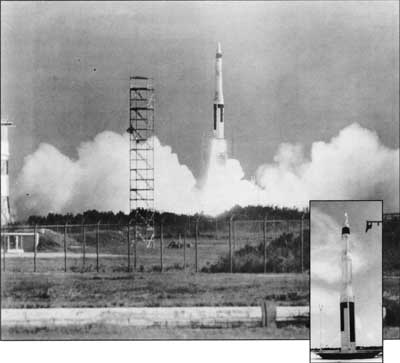
|
|
Minuteman I test launch. Inset: A Minuteman ICBM, ready for testing at the Air Force Missile Test Center, Cape Canaveral, Florida. US AIR FORCE. |
According to journalist Roy Neal, the ICBM program created a new national industry: "Tens of thousands of industrial and Air Force managers, engineers, and workers [had] to be trained. New machine tools and test facilities [had to] come into being. . . . " These efforts changed "the face of America, the make-up of the Armed Forces and the industries that support them. "
At the end of 1960, the Air Force took the first Minuteman missile to Cape Canaveral, Florida, for flight testing. The compact new missile was only six feet in diameter and 53 feet high — about half the size of a Titan. Minuteman's three cylindrical, steel-cased propulsion stages were stacked one atop the other, with each stage slightly smaller in diameter than the one beneath it. Each stage was filled with a rubbery mixture of fuel and oxidizer, molded around a hollow, star-shaped core. The Minuteman's guidance system occupied a small compartment above the third stage. The "reentry vehicle" at the tip was identical to the nose-cone that would eventually contain a thermonuclear warhead.
Following two aborted launch attempts, the Air Force successfully fired the first Minuteman missile at 11:00 a. m. on February 1, 1961. Even the most experienced missile watchers found it to be "a dazzling spectacle." When the missile's first-stage engine ignited, there was a loud bang. Then the missile began to rise on a column of flame and smoke. Unlike the Atlas or Titan missile, which one observer said left the ground "like a fat man getting out of an easy chair," the Minuteman missile "shot up like a skyrocket." The missile performed flawlessly. The three propulsion stages completed their burns on schedule, then detached themselves and plummeted back to earth, while the unarmed warhead hurled on toward its assigned destination. Twenty-five minutes after lift-off, the reentry vehicle splashed down in the Atlantic Ocean squarely on target — 4,600 miles away.
From his office in Washington D. C. , Air Force Chief of Staff General Thomas D. White described the launch as "one of the most significant steps this Nation has ever taken toward gaining intercontinental missile supremacy." An engineer who witnessed the event put it another way: "Brother," he said, "there goes the missile gap."
The "Underground" Air Force
By the time the flight test took place, the Air Force was already planning for Minuteman missile deployment. According to historian Jacob Neufeld, the Air Force conceptually developed its "ideal" ICBM base in 1955, during the early days of the Atlas program:
The missile would be sited inside fixed, underground facilities; it was to have a quick launch reaction; it was to be stored in a launching position; the launch site would require minimal support; and the launch units were to be self-supporting for two weeks.
Turning these ideas into reality, however, proved difficult. During the height of the "missile gap" hysteria, the Air Force hastily activated the Nation's first Atlas missiles at Vandenberg Air Force Base in California. Here, the Air Force stored the missiles horizontally in "coffins" — concrete-walled, above-ground enclosures. Before the missiles could be fired, servicemen had to raise each missile vertically on a launch pad and add fuel. The later Titan and Atlas F series missiles were stored upright in underground silos capped with massive "clamshell" doors. But Air Force engineers were worried that vibrations from the rocket engines might shake the missiles apart before launch. As a result, the Air Force equipped each silo with an elevator that raised the missile to the surface for firing. Although the missiles were stored with their tanks full of fuel, workers still needed to add volatile liquid oxygen right before launch.
The Air Force took a major step toward achieving its ideal basing system in 1960 with the development of Titan II, which used storable liquid propellants. The Air Force could store Titan II missiles with fully-loaded propellant tanks, and fire them directly from underground silos. Nonetheless, Titan II missiles still needed constant attention from an on-site crew.
When Minuteman was added to the Nation's arsenal, America acquired its first truly pushbutton — literally turn-key — missile system. Historian Ernest Schwiebert noted:
With the successful utilization of solid propellants, the Minuteman could hide in its lethal lair like a shotgun shell, ready for instant firing. The operational launcher could be unmanned, underground, and hardened to withstand the surface burst of a nuclear weapon. Each launcher housed a single weapon and the equipment necessary to support and fire it, and required only periodic maintenance. The missiles could be fired ... at a moment's notice.
| Evolution of ICBM Launch Facilities |
|
Just as ICBMs evolved, so did their launch facilities. The first Atlas missiles were stored upright on launch pads, where they were vulnerable to attack. Later, the missiles were kept in horizontal, concrete "coffins" and raised vertically before launch. Eventually, the Air Force moved ICBMs to underground silos; elevators lifted them to the surface for launch. Titan II and Minuteman were the first ICBMs launched directly from underground silos. |

|
Minuteman Deployment and Site Selection
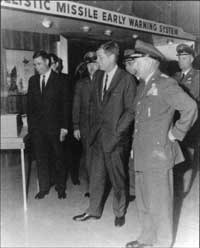
|
|
President John F. Kennedy (center), accompanied by Secretary of Defense Robert McNamara (far left), SAC Commander General Thomas S. Power (right), and Lt. General Howell M. Estes, Jr. (right background) at Vandenberg Air Force Base, March 1962. US AIR FORCE, HISTORY DIVISION. |
The Air Force wanted to deploy Minuteman as a single, immense, "missile farm," equipped with as many as 1,500 missiles. However, the Air Force soon determined that "for reasons of economy 150 launchers should be concentrated in a single area, whenever possible, and that no area should contain fewer than 50 missiles." Consequently, the Air Force organized the Minuteman force into a series of administrative units called "wings," each comprised of three or four 50-missile squadrons. Each squadron was further subdivided into five smaller units, called "flights." A flight consisted of a single, manned, launch control facility, linked to ten, unmanned, underground, missile silos. The silos were separated from the launch control facility and from each other by a distance of several miles.
The Air Force initially considered putting Minuteman missiles as far south as Georgia, Texas, and Oklahoma. But when early models of Minuteman missiles fell short of their intended 5,500-mile range, the Air Force selected sites in the northern part of the United States, which was closer to the Soviet Union. In 1960, the Air Force decided to locate the first Minuteman installation on the high plains around Great Falls, Montana, at Malmstrom AFB. In the event of a nuclear accident or attack, the low population density near Malmstrom AFB would minimize civilian casualties. In addition, the region offered an established network of roads and, like much of the West, a large amount of easy-to-acquire public land.
The Air Force began constructing the Nation's first Minuteman missile field on March 16, 1961. In the spring of 1962, the Associated Press reported that the Montana silos were being "rushed to completion," and that the first missiles, each loaded with "one megaton of death and destruction," would be ready by late summer. Air Force crews began lowering the weapons into the silos at the end of July, and Malmstrom AFB's first ten-missile flight was hurriedly activated on October 27, 1962, at the height of the Cuban Missile Crisis.
Minuteman Comes to Ellsworth Air Force Base
Military strategists began planning for a second Minuteman installation shortly after work got underway at Malmstrom AFB. In June 1960, the Air Force was authorized to add another 150 missiles to the Minuteman force. By early October, military strategists had narrowed their search for a new site to three locations in North and South Dakota. On January 5, 1961, US Senator Francis Case of South Dakota announced that Ellsworth AFB would be the headquarters for the Nation's second Minuteman deployment. Located about 12 miles east of Rapid City, Ellsworth AFB was founded in 1941 as the Rapid City Army Air Base. The Air Corps used the airfield to train B-17 bomber crews, and Ellsworth eventually served as home base for many of America's largest strategic bombers. The base was also headquarters for a Titan I missile squadron.
| The 44th Strategic Missile Wing |
|
Typical of all Minuteman installations, I the forces at Ellsworth AFB were organized into a missile wing. The 44th Strategic Missile Wing at Ellsworth AFB was activated in 1963, and was comprised of three 50-missile squadrons: the 66th, 67th, and 68th Strategic Missile Squadrons. Each squadron was further subdivided into five smaller units, called flights. A flight consisted of a single, manned, underground launch control center (LCC), which was linked through a system of underground cables to ten, unmanned, launch facilities (LF). Each LF held one Minuteman missile stored in an underground silo. The silos were separated from the LCC and each other by a distance of several miles. |
Although the Defense Department had not yet officially authorized the South Dakota Minuteman installation, Senator Case wanted the land acquired immediately so there would be "no loss of valuable time" once the project was approved. Local ranchers did not share Case's sense of urgency. Fearing that the government might offer below-market prices for their land, the ranchers established the Missile Area Landowners' Association to negotiate fair prices. The association assured fellow citizens that its actions would "not necessarily slow the national defense effort."
While real estate negotiations were underway, the South Dakota State Highway Department spent $650,000 from the Federal Bureau of Public Roads to improve 327 miles of roads leading to the proposed missile sites. By June 1961, Boeing was busy improving the infrastructure. Anticipating that the project would bring in more than 3,000 workers, the company raced to build mobile home camps and cafeterias near Wall, Sturgis, Belle Fourche, and Union Center, as well as in Rapid City.
By early summer, more than three-quarters of the local landowners agreed to give the government access to their land. Once the sites were finalized, the Ralph M. Parsons Company, an architectural and engineering firm from Los Angeles, prepared plans for the Minuteman installation. The Air Force assigned responsibility for construction to the US Army Corps of Engineers Ballistic Missile Construction Office. In July 1961, four of the nation's largest construction firms submitted bids for the project. The low bid came from Peter Kiewit Sons Company of Omaha, whose estimate of $56,220,274 was nearly $10 million below government projections.
A Silo A Day
On September 10, 1961, the groundbreaking ceremony for Ellsworth AFB's Minuteman installations took place at Site L-6 near Bear Butte. The festivities started with a bang. While the Sturgis High School band played, representatives from Boeing, Kiewit, the Corps of Engineers, and Ellsworth AFB set off an explosive charge to begin the excavation.
Despite extreme cold, high winds, and heavy snowfall, construction proceeded at a furious pace through the winter of 1961-62. In mid-December, the Corps of Engineers told reporters that "men are working seven days a week, three shifts a day on Minuteman construction. " A Corps spokesman said that crews were "able to dig five silo emplacements simultaneously. Each takes from four to ten days . . . " The first squadron, near Wall, was well underway, said the Corps, and work on the second squadron, near Union Center, had already started. In February 1962, General Delmar Wilson told the Rapid City Chamber of Commerce that despite an ongoing labor dispute between Peter Kiewit Sons and the Ironworkers Union, South Dakota's ICBM deployment suffered fewer work stoppages than any missile program in the Nation. "We're all out . . . to assure that our way of life is maintained," stated Wilson. "This missile project ... is the number one project in the country today. If this guy in Russia wants to start a show, we'll be there to put a hole in him to the best of our ability."
By early summer of 1963, the steel fabrication was finished at all 165 South Dakota sites, and crews were completing the silos at the rate of one per day. On the last day of June, the first 20 silos were turned over to the Strategic Air Command. On October 23, the Nation's second wing of Minuteman ICBMs was fully operational. The work was completed nearly three weeks ahead of schedule.
| Construction of a Minuteman LF | |||
|
| Construction of a Minuteman LCF |
|
Delta One's underground launch control center (LCC) was constructed as two separate structural elements. The outside protective shell is 29 feet in diameter and 54 feet in length, and is made of reinforced concrete with four-foot-thick walls. The shell's interior is lined with 1/4-inch-thick steel plate. Suspended inside the shell is the second element: a box-like acoustical enclosure that contains the launch control consoles, communications and monitoring equipment, and crew accommodations. Delta One's "topside" structures include sleeping and eating facilities.
|
Backbone of the US Nuclear Arsenal
While the Ellsworth AFB sites were under construction, the Air Force was building several other Minuteman installations. By the end of 1967, the Nation had 1,000 Minuteman missiles on alert in six separate deployment areas located throughout the north-central United States. In addition to the original installations at Malmstrom AFB and Ellsworth AFB, Minuteman complexes were deployed at Minot AFB and Grand Forks AFB in North Dakota, Whiteman AFB in Missouri, and F .E. Warren AFB in Wyoming. In addition, another squadron was established at Malmstrom AFB. At each installation the Air Force continued to improve and refine the Minuteman operational system.
Newly-elected President John F. Kennedy instigated one of the first significant improvements to the Minuteman weapon system. Soon after taking office in 1961, Kennedy learned that even if he ordered a massive nuclear retaliation to a Soviet attack, a portion of the Soviet's long-range nuclear force would survive to strike again. As a consequence, the Kennedy administration quickly abandoned the strategic policy of releasing America's entire nuclear arsenal in "one horrific spasm." Instead of massive retaliation, Secretary of Defense Robert McNamara recommended a "flexible response." Should deterrence fail, McNamara proposed that America's nuclear weapons be deployed selectively. The first ICBMs would target enemy bombers and missile sites. The remaining ICBMs would be held in reserve, for potential use against Soviet cities. McNamara hoped that the threat to the civilian population would persuade the Soviet Union to end the conflict. McNamara began retooling America's nuclear forces, including Minuteman, to reflect the new military strategy.
However, Colonel Edward Hall and his engineers designed Minuteman to be a fastreacting, mass-attack weapon. Upon receiving the launch command, the officers at each Minuteman facility had to fire all ten missiles under their control. A selective launch of fewer than ten missiles was impossible. In order to conform with the new defense strategy, Air Force engineers had to redesign Minuteman's launch control complex. Historian Clyde Littlefield described the changes:
In order to conform to the new concept, engineering changes had to be made to allow a combat crew in a control center to switch targets and to fire one or more missiles selectively, conserving the remainder for later use.... Greater flexibility in targeting and firing required a significant extension to the limited survival time [of each operational site]. The [original] Minuteman facility design did not provide for the protection of the power supply.... At a control center, power generators were above the ground.... When and if these generators stopped functioning, the operational potential of the system would be reduced to only six hours. Revised strategic concepts required that the weapon survive at least nine weeks after an initial enemy attack.
To meet this requirement, the Air Force put the generators in underground capsules next to each launch control center. Although the Air Force considered incorporating these generators into the Minuteman facilities at Ellsworth AFB, construction was already underway there, making the changes impractical. Consequently, the generator capsules began with the third Minuteman deployment area at Minot AFB in North Dakota.
The Next Generations: Minuteman II and III
By the time planning began for the final Minuteman deployment area, the Air Force had developed a vastly improved version of the missile. Called Minuteman II, the new missile offered improved range, greater payload, more flexible targeting, and greater accuracy, leading one Air Force spokesperson to estimate that its "kill capacity" was eight times that of Minuteman I. Minuteman II was deployed first at Grand Forks AFB, North Dakota. In September 1965, South Dakota Congressman E.Y. Berry announced that the Ellsworth AFB facilities would also receive the new missile system. According to Berry, Minuteman II would help Ellsworth AFB remain "one of the nation's most important military installations." In October 1971, Boeing began refitting the Ellsworth silos to accommodate Minuteman II, and completed the project in March 1973.
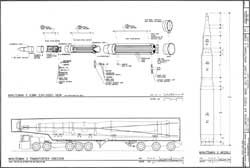 |
|
Ellsworth Air Force Base: Delta Flight, Minuteman II ICBM. HISTORIC ENGINEERING RECORD, NATIONAL PARK SERVICE (click on image for an enlargement in a new window) |
In May 1964, the Soviet Union displayed a battery of anti-ballistic missiles in Moscow's Red Square, prompting concern about the vulnerability of Minuteman I and II missiles. The following year, the Air Force began to develop an even more advanced version of the missile. By late summer of 1968, Minuteman III was ready for testing. Longer and more powerful than its predecessors, Minuteman III offered an improved guidance system that could be retargeted in minutes. But, according to the New York Times, the missile's "most telling advantage" lay in its "revolutionary new warhead: the MIRV, or multiple independently targeted reentry vehicle." The MIRV could deliver three hydrogen bombs to widely scattered targets, a capability that would "render current and contemplated antimissile defense systems largely inadequate," and "thrust the world into a new era of weapons for mass destruction."
The Air Force deployed Minuteman III at Warren, Minot, Grand Forks, and Malmstrom Air Force Bases, and extensively modified the Minuteman launchers at these locations to accommodate the new missiles. Each launch tube was equipped with a new suspension system that could hold the missile absolutely motionless during the aftershocks of a nuclear attack. The Air Force also installed a system of seals, filters, and surge arrestors designed to prevent electronic equipment from being damaged by the powerful electromagnetic waves generated during nuclear explosions.
In July 1975, when the last of the Nation's 550 Minuteman III missiles was lowered into its silo at Malmstrom AFB, Montana, only 450 Minutemen II remained in the American arsenal — at Malmstrom, Ellsworth, and Whiteman Air Force Bases. This force structure remained intact for nearly two more decades.
| Evolution of Minuteman Facilities |
|
The first Minuteman LCCs, such as Delta One, were dependent on life-support equipment in the above-ground LCF support building. In later versions, the Air Force buried the life-support equipment underground to help it better withstand a nuclear attack.
The Air Force also redesigned the launch facilities to improve survivability. The power supply unit (shown to the right of each silo) was buried deeper underground, and encapsulated in hardened concrete. The Delta Nine site represents the earliest configuration.
|
Deactivation of the Minuteman II Weapon System
The fall of the Berlin Wall in November 1989 marked the beginning of the end of the Cold War. On July 31, 1991, President George Bush and Soviet leader Mikhail Gorbachev signed the Strategic Arms Reduction Treaty (START), which placed a limit on the worldwide number of ICBMs and prescribed a process for their destruction. The treaty coincided with the end of the Cold War, and the Air Force's growing disenchantment with the escalating costs of repairing and maintaining the Minuteman II system. On September 27, 1991, President Bush announced on national television his "plan for peace." As part of the plan, Bush called for "the withdrawal from alert, within 72 hours," of all 450 Minuteman II missiles, including those at Ellsworth AFB.
On December 3, 1991, an Air Force crew arrived to remove the first of Ellsworth AFB's 150 Minuteman II missiles: Golf Two (G-2), a launch facility near Red Owl, about 60 miles northeast of Rapid City. The Rapid City Daily Journal reported on the crew's progress.
Disarmament began with snow shovels at dawn ... as Airman 1st Class James Comfert and his colleagues cleared the launch-door rail.... Six hours later, a Minuteman II intercontinental ballistic missile was stored safely in its transporter/erector truck. G-2 was just a high-tech hole in the ground.
According to the Rapid City Daily Journal, the Minuteman deactivation process at Ellsworth AFB would continue for at least three more years:
First, warheads and guidance systems [will be] removed. Then the missiles will be pulled. . . . The headframes of the missile silos will be destroyed and the tubes will be filled with rubble. The launch control capsules will be buried under rubble and a thick concrete cap. The land and above-ground buildings at launch control centers will be sold.
Although all of the Minuteman II facilities at Ellsworth AFB were slated for demolition, the Air Force, in conjunction with the National Park Service, selected two representative sites — Launch Control Facility Delta One and Launch Facility Delta Nine — for possible preservation as nationally significant icons of the Cold War. When the Minuteman II deactivation is completed in the mid-1990s, these two Ellsworth AFB sites will be the only remaining intact examples of the original Minuteman configuration.
| Delta Nine Missile Pull, 1993 |
|
On September 27, 1991, President George Bush announced his "plan for peace," which included the "withdrawal from alert, within 72 hours, of all 450 Minuteman II intercontinental ballistic missiles." The actual physical removal of the missiles began in December 1991, when Air Force crews began pulling the unarmed Minutemen from their silos. Cables were lowered from a transporter/erector truck and attached to the missile by a crew inside the silo. The missile was then slowly raised into the truck and secured for transport.
|
HISTORY & CULTURE
Introduction | Parkland Criteria | Minuteman History | Site Description | Bibliography
Source: Minuteman Missile Sites: Special Resource Study, 1995.

